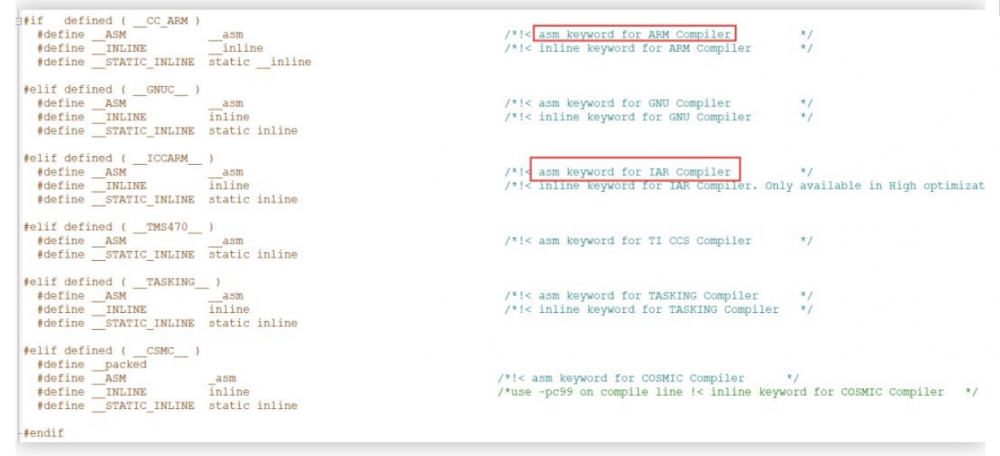概 述
有认真研究,或者说细心一点的读者应该都知道:C中定义汇编代码与编译器有关。比如,你在core_cm4.h文件会看到如下的代码:
#if defined ( __CC_ARM ) #define __ASM __asm /*!< asm keyword for ARM Compiler */ #define __INLINE __inline /*!< inline keyword for ARM Compiler */ #define __STATIC_INLINE static __inline
#elif defined ( __GNUC__ ) #define __ASM __asm /*!< asm keyword for GNU Compiler */ #define __INLINE inline /*!< inline keyword for GNU Compiler */ #define __STATIC_INLINE static inline
#elif defined ( __ICCARM__ ) #define __ASM __asm /*!< asm keyword for IAR Compiler */ #define __INLINE inline /*!< inline keyword for IAR Compiler. Only available in High optimization mode! */ #define __STATIC_INLINE static inline
#elif defined ( __TMS470__ ) #define __ASM __asm /*!< asm keyword for TI CCS Compiler */ #define __STATIC_INLINE static inline
#elif defined ( __TASKING__ ) #define __ASM __asm /*!< asm keyword for TASKING Compiler */ #define __INLINE inline /*!< inline keyword for TASKING Compiler */ #define __STATIC_INLINE static inline
#elif defined ( __CSMC__ ) #define __packed #define __ASM _asm /*!< asm keyword for COSMIC Compiler */ #define __INLINE inline /*use -pc99 on compile line !< inline keyword for COSMIC Compiler */ #define __STATIC_INLINE static inline#endif

如果你写过Keil C51,你还会发现有如下(通过预处理)嵌套汇编:
#pragma asm
; Assembler Code Here
#pragma endasm
所以,你会发现,不同的编译器,汇编代码还是有差异。当然,这里主要是说C中嵌套汇编与编译器有关。
C中嵌套汇编代码
常见的两种定义:• 在C函数中定义一段汇编代码• 在C文件中定义一个汇编函数当然,两个意思差不多,都是在C中嵌套汇编。
上面说了C中定义汇编代码与编译器有关,换句话说:不同编译器解析汇编代码的方式不同。
这里还是拿core_cm3.c来举例说明,定义一个__get_PSP函数。
在Keil MDK中定义:
__ASM uint32_t __get_PSP(void){ mrs r0, psp bx lr}在IAR EWARM中定义:uint32_t __get_PSP(void){ __ASM("mrs r0, psp"); __ASM("bx lr");}__asm(__ASM)关键字用于调用内联汇编程序,并且可在 C 或 C++ 语句合法时出现。举 例
下面举一些常见的例子。1、FreeRTOS中portmacro.h文件下源代码:
static portFORCE_INLINE void vPortRaiseBASEPRI( void ){uint32_t ulNewBASEPRI = configMAX_SYSCALL_INTERRUPT_PRIORITY;
__asm { /* Set BASEPRI to the max syscall priority to effect a critical section. */ msr basepri, ulNewBASEPRI dsb isb }}
2、FreeRTOS中port.c文件下源代码:
__asm void xPortPendSVHandler( void ){ extern uxCriticalNesting; extern pxCurrentTCB; extern vTaskSwitchContext;3、内核复位
PRESERVE8
mrs r0, psp isb
ldr r3, =pxCurrentTCB /* Get the location of the current TCB. */ ldr r2, [r3]
stmdb r0!, {r4-r11} /* Save the remaining registers. */ str r0, [r2] /* Save the new top of stack into the first member of the TCB. */
stmdb sp!, {r3, r14} mov r0, #configMAX_SYSCALL_INTERRUPT_PRIORITY msr basepri, r0 dsb isb bl vTaskSwitchContext mov r0, #0 msr basepri, r0 ldmia sp!, {r3, r14}
ldr r1, [r3] ldr r0, [r1] /* The first item in pxCurrentTCB is the task top of stack. */ ldmia r0!, {r4-r11} /* Pop the registers and the critical nesting count. */ msr psp, r0 isb bx r14 nop}
这是之前分享过的一篇文章《一文弄懂STM32复位来源,以及系统与内核复位的区别》中的代码:
__asm void NVIC_CoreReset_a(void){ LDR R0, =0xE000ED0C LDR R1, =0x05FA0001 STR R1, [R0]deadloop_Core B deadloop_Core}以上这些常见例子,可能还没有说透,但相信只要认真理解了都能明白。
 我要赚赏金
我要赚赏金

